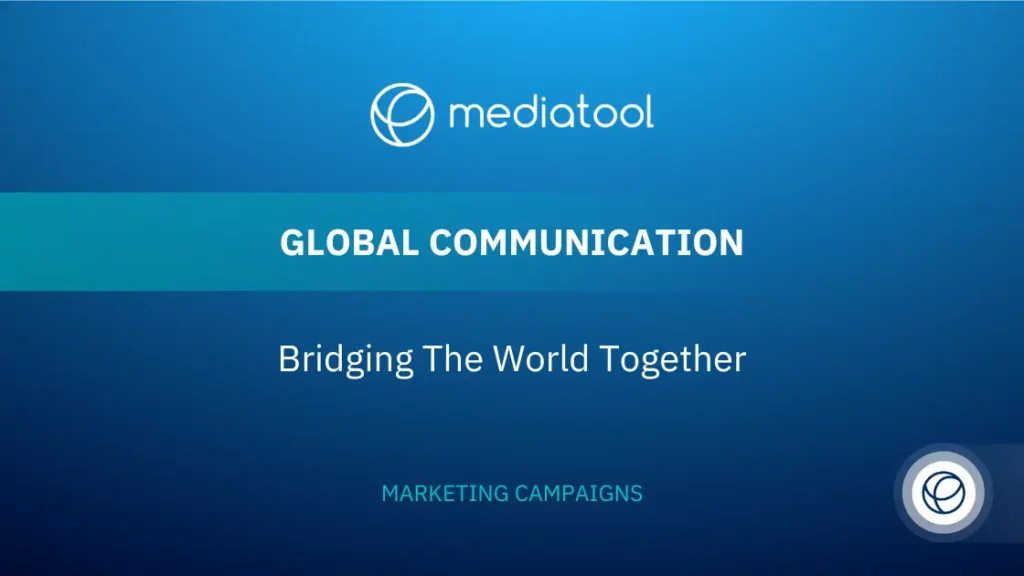In today’s global marketplace, effective communication is one of the most important things for marketing success.
It helps brands overcome barriers, reach diverse audiences, and connect with consumers worldwide.
But what exactly is its role in marketing? And how can brands use it to their advantage?
Let’s dive into the essentials of global communication in marketing and advertising.
What is Global Communication?
Global communication is the strategic art of crafting and disseminating messages that resonate with audiences worldwide.
It involves leveraging media, cutting-edge technology, and innovative strategies to ensure that brand messages reach diverse cultures and engage them meaningfully.
This dynamic process is essential for brands looking to establish a global presence, enabling them to connect with consumers across different geographies and cultural landscapes. It’s the backbone of creating campaigns that spark conversations, forge emotional connections, and build brand loyalty on a global scale.
Mastering global communication is non-negotiable for businesses aiming to thrive in the international market. It involves more than just translating content; it’s about adapting your message to align with local sensibilities, customs, and consumer behaviors.
This nuanced approach to marketing and advertising ensures that campaigns are not just seen but felt, fostering a sense of inclusion and relevance among global audiences.
Global communication also plays a pivotal role in innovation within the marketing industry. It encourages marketers to think beyond borders, designing campaigns that leverage universal human emotions while catering to specific cultural nuances. This global mindset helps scale businesses internationally and create advertising content that’s both universally appealing and locally engaging.
At its core, global communication in marketing is about bridging the gap between brands and the world’s diverse population. It transforms the way companies communicate, allowing them to tell their stories in a way that’s accessible and impactful to people, no matter their location.
It’s not just about broadcasting a message; it’s about starting a global conversation where every voice can be heard and every consumer feels seen.
Benefits of Global Communication
Enhancing Brand and Cultural Engagement
Global communication is key to transcending cultural barriers, enabling brands to engage with diverse audiences meaningfully. Companies can craft marketing campaigns that resonate deeply with global consumers by exchanging cultural insights and narratives.
This is not just about broadcasting a message but about creating a dialogue acknowledging and celebrating cultural diversity. Such engagement helps brands navigate the nuances of international markets, ensuring their messaging is both relevant and respectful.
This approach fosters brand loyalty and builds a global community around shared values and experiences.
Driving International Business Growth
Effective global communication is the catalyst for business expansion and the development of international markets. By leveraging targeted advertising and marketing strategies, companies can introduce their products and services to new audiences, adapting their approach to meet local preferences and demands.
This strategic communication facilitates the creation of international brands and supports the scaling of operations across borders, contributing significantly to economic growth. Communicating effectively with diverse markets is essential to a brand’s global success and sustainability.
Influencing Global Consumer Perceptions
Marketing and advertising play a crucial role in shaping public perceptions on a global scale, including political and social awareness. Through strategic communication efforts, companies can introduce narratives that promote their brands and address global issues, encouraging a well-informed and engaged consumer base.
This power to influence comes with a responsibility to foster positive change and support public discourse, making brands important players in the global conversation.
Expanding Educational and Professional Opportunities
The global reach of digital marketing and online platforms offers unprecedented access to educational content, professional development resources, and global networking opportunities. For students and professionals alike, this means being able to learn about global market trends, consumer behavior, and advertising strategies from anywhere in the world.
Marketing education programs, including those focused on global communication, equip individuals with the skills to thrive in the international marketplace. Internships with global companies further prepare individuals for careers in a dynamic, globally connected industry, allowing them to gain hands-on experience.
What are some tools and techniques for developing a global marketing communication mix?
Developing a global marketing communication mix requires a strategic blend of tools and techniques to reach and resonate with international audiences effectively. Here’s a look at some key components:
- Digital Platforms and Social Media: In the current digital era, online platforms and social media have become crucial for global marketing efforts. Businesses use these channels to connect with customers worldwide, tailoring content to match local preferences while ensuring their brand message remains consistent. With 5.35 billion people, or 66.2% of the global population, using the internet, and 5.04 billion, or 62.3%, actively engaging on social media as of January 2024, the reach and impact of digital marketing are unprecedented. Techniques like SEO and targeted advertising are more important than ever, ensuring that messages not only reach a vast audience but also resonate with them through personalized and culturally relevant content.
- Content Localization and Translation Services: To communicate effectively with global audiences, it’s essential to localize content, not just translate it. This means adapting messages to reflect local culture, values, and language nuances. This adaptation ensures messages resonate more deeply on a local level. With 84% of businesses observing a noticeable positive effect on revenue growth through content localization, the value of professional translation and localization services becomes clear. These experts are crucial in making marketing materials not only accurate in language but also relevant and engaging to diverse cultures, underlining the importance of tailored communication in global marketing strategies.
- Cross-Cultural Marketing Strategies: Understanding and respecting cultural differences is key to developing an effective global marketing communication mix. This involves research to identify cultural norms, preferences, and taboos in target markets. Strategies are then tailored to align with these insights, from choosing appropriate images and colors to deciding on the tone and style of communication.
- Mobile Marketing: With the widespread use of cell phones globally, mobile marketing has become a powerful tool for reaching audiences anywhere, anytime. SMS campaigns, mobile apps, and responsive web design are all used to engage mobile users. This approach allows for personalized communication, enhancing customer engagement and loyalty.
- Public Relations and Global Events: Public relations efforts, including press releases, partnerships with local influencers, and participation in global events, help build brand awareness and credibility in different markets. Companies can draw attention from a broad audience by aligning with events with international appeal or hosting global webinars.
- Interactive and Immersive Experiences: Technologies like virtual reality (VR) and augmented reality (AR) offer innovative ways to create immersive brand experiences for global audiences. These tools can transport users to virtual environments or enhance physical spaces with digital information, providing memorable and engaging ways to experience a brand.
- Email Marketing: Despite the proliferation of new technologies, email remains a cornerstone of global communication strategies. It allows for direct, personalized communication with audiences worldwide. Segmenting email lists by location, interests, and behaviors ensures that messages are relevant and targeted. This approach is especially relevant considering that 61% of people favor email as their primary channel for business communications, underscoring the enduring value and effectiveness of email marketing in a digitally connected world.
- Influencer Collaborations: Partnering with influencers who have a worldwide following can significantly extend a brand’s reach and credibility. These influencers, adept at understanding and conveying cultural subtleties, can communicate with local audiences in a way that feels genuine and engaging. This capability makes them indispensable in global marketing campaigns, more so in a landscape where the influencer marketing market has seen a threefold increase since 2019, reaching an impressive $24 billion by 2024.
By integrating these tools and techniques into a comprehensive global marketing communication mix, companies can effectively communicate their brand’s message and values to a diverse global audience, fostering engagement, loyalty, and growth on an international scale.
Developing a Successful Global Communication Strategy

Crafting an effective global communication strategy is essential for tapping into the vast potential of international engagement.
Let’s dive deeper into how to achieve this.
Understand Your Audience
At the heart of global communication is a profound understanding of your audience’s cultural contexts, languages, and practices. This understanding is not just about avoiding faux pas; it’s about respecting and valuing the rich tapestry of global diversity.
Tailoring your message to align with these differences ensures it resonates more deeply and authentically with your intended audience. For the global team, this means developing messages that are inclusive and considerate of the various cultural backgrounds represented in the team and the broader audience.
Leverage Technology Wisely
In our digital age, technology such as the internet, cell phones, and social media platforms are indispensable tools for global communication. These technologies break down geographical barriers, instantly allowing messages to reach a global audience.
However, leveraging technology wisely means choosing the right platforms and formats for your message and audience.
For instance, while social media may be a powerful tool for engaging with a younger, more tech-savvy audience, more traditional forms of media might be more effective in regions with limited internet access.
Foster Open Dialogue
Encouraging open dialogue is about creating a two-way street in communication. It’s not sufficient to simply broadcast your message; you must also be open to listening and responding to feedback. This approach builds trust and fosters a sense of community among your audience.
For businesses and organizations, this means actively seeking out and addressing their global teams’ and stakeholders’ concerns and insights, thereby enhancing public relations and ensuring a more engaged and committed workforce.
Embrace Language Diversity
While the English language dominates global business and media, acknowledging and incorporating multiple languages into your communication strategy can significantly boost engagement.
Offering content in local languages or providing translation services can help reach a wider audience and show respect for linguistic diversity. This practice is increasingly important in global operations where language can hinder effective communication and collaboration.
Prioritize Education and Training
Investing in education and training is crucial for organizations that operate globally. This can include developing a global communication program offering core courses in international relations, political science, and professional studies.
These programs prepare professionals to navigate the complexities of global communications with a blend of theoretical knowledge and practical, hands-on experience. For global teams, continuous training in cultural sensitivity and communication skills is vital for enhancing their ability to work across cultural boundaries.
Global communication is both an art and a science, requiring the right technological tools and a nuanced understanding of our diverse world. As we advance into the future, the importance of global communication continues to grow, offering endless opportunities for innovation, collaboration, and progress.
Conclusion
Global communication serves as the lifeblood of our connected world, molding our perceptions, propelling our economies forward, and drawing us nearer to far-flung cultures and communities.
By adopting deliberate strategies, dedicating ourselves to cultural sensitivity, and eagerly adopting technology, we all play a part in fostering a global society that’s more interconnected and communicative.
Looking to learn more about how you can develop and optimize global marketing campaigns?
Look no further!
Take a tour of Mediatool to see how you can manage all your global campaigns from a single source of truth.





